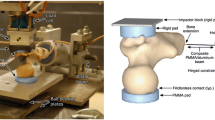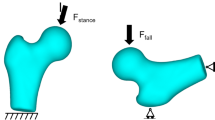Abstract
Results from previous quasi-static mechanical tests indicate that femurs from elderly subjects fail in vitro at forces 50% below those available in a fall from standing height. However, bone is a rate-dependent material, and it is not known whether this imbalance is present at rates of loading which occur in a fall. Based on recent data on time to peak force and body positions at impact during simulated falls, we designed a high rate test of the femur in a loading configuration meant to represent a fall on the hip. We used elderly (mean age 73.5±7.4 (SD) years) and younger adult (32.7±12.8 years) cadaveric femurs to investigate whether (1) the strength, stiffness, and energy absorption capacity of the femur increases under high rate loading conditions; (2) elderly femurs have reduced strength, stiffness, and energy absorption capacity compared with younger adult femurs at this loading rate; and (3) densitometric and geometric measures taken at the hip correlate with the measured fracture loads. Femurs were scanned using dual-energy X-ray absorptiometry (DXA) and then tested to failure in a fall loading configuration at a displacement rate of 100 mm/second. The fracture load in elderly and younger adult femurs increased by about 20% with a 50-fold increase in displacement rate. However, energy absorption did not increase with displacement rate because of a twofold increase in stiffness at the higher loading rate. Age-related differences in strength and energy absorption capacity were consistent with those found previously for a displacement rate of 2 mm/second. There were moderate to strong correlations between fracture load and DXA variables, with the best correlation provided by cross-sectional area (r2=0.77) and bone mineral density (BMD) (r2=0.72) at the femoral neck. Our results indicate that, even at rates of loading applied during a fall, the estimated impact force in a fall on the hip is 35% greater than the average fracture load of the elderly femur. Moreover, the relationship we found between femoral neck BMD and fracture load indicates that an increase in femoral neck BMD of more than 20% would be required to raise the strength of the femur to the level of the impact load. As clinical trials of pharmacologic interventions have demonstrated increases in BMD of only a few percent at best, our results emphasize the continuing need for intervention strategies that focus on fall prevention and on reducing the severity of those falls that do occur.
Similar content being viewed by others
References
Melton LJ III (1993) Epidemiology of age-related fractures. In: Avioli LV (ed) The osteoporotic syndrome: detection, prevention, and treatment, 3rd ed. Wiley-Liss, Inc. New York, pp 17–38
American Academy of Orthopaedic Surgeons (1993) A Position statement: prevention of hip fractures. AAOS Rosemont, IL, June
Vierck E (1990) Fact book on aging. ABC-CLIO, Inc, Santa Barbara, CA, p 4
Black DM, Cummings SR, Genant HK, Nevitt MC, Palermo L, Browner W (1992) Axial and appendicular bone density predict fractures in older women. J Bone Miner Res 7:633–638
Cummings SR (1985) Are patients with hip fractures more osteoporotic? Am J Med 78:487–494
Martin RB, Burr DB (1984) Aging effects. In: Structure, function, and adaptation of compact bone. Raven Press, New York, pp 215–233
Hedlund R, Lindgren U (1987) Trauma type, age and gender as determinants of hip fracture. J Orthop Res 5:242–246
Grisso JA, Kelsey JL, Strom BL, Chiu GY, Maislin G, O'Brian LA, Hoffman S, Kaplan F (1991) Risk factors for falls as a cause of hip fracture in women. N Engl J Med 324:1326–1331
Greenspan SL, Myers ER, Maitland LA, Resnick NM, Hayes WC (1994) Fall severity and bone mineral density as risk factors for hip fracture in ambulatory elderly. JAMA 271:128–133
Courtney AC, Wachtel EF, Myers ER, Hayes WC (in press) Age-related reductions in the strength of the femur tested in a fall loading configuration. JBJS
Lotz JC, Hayes WC (1990) The use of quantitative computed tomography to estimate risk of fracture of the hip from falls. J Bone Joint Surg 72-A:689–700
Weber TG, Yang KH, Woo R, Fitzgerald RH Jr (1992) Proximal femur strength: correlation of the rate of loading and bone mineral density. ASME Adv Bioengineering 22:111–114
Robinovitch SN, Hayes WC, McMahon TA (1991) Prediction of femoral impact forces in falls on the hip. J Biomech Eng 113: 366–374
van den Kroonenberg A, Munih P, Weigent-Hayes M, McMahon T (1992) Hip impact velocities and body configurations for experimental falls from standing height. 39th ORS, p 24
Kelly TL (1990) Bone mineral density reference databases for American men and women. J Bone Miner Res 5 (suppl 2): S249
Myers ER, Hecker AT, Rooks DS, Hipp JA, Hayes WC (1993) Geometric variables from DXA of the radius predict forearm fracture load in vitro. Calcif Tissue Int 52:199–204
Myers ER, Sebeny EA, Hecker AT, Corcoran TA, Hipp JA, Greenspan SL, Hayes WC (1991) Correlations between photon absorption properties and failure load of the distal radius in vitro. Calcif Tissue Int 49:292–297
Backman S (1957) The proximal end of the femur. Acta Radiol (suppl) 146:1–16
Smith LD (1953) Hip fracture: the role of muscle contraction or intrinsic forces in the causation of fractures of the femoral neck. J Bone Joint Surg 35-A:367–382
Hall ML, Heavens J, Ell PJ (1991) Variation between femurs as measured by dual energy x-ray absorptiometry (DEXA). Eur J Nucl Med 18:38–40
Curry JD (1988) Strain rate and mineral content in fracture models of bone. J Orthop Res 6:32–38
Wright TM, Hayes WC (1976) Tensile testing of bone over a wide range of strain rates: effects of strain rate, microstructure and density. Med Biol Eng 14:671–679
Peterson DL, Skraba JS, Moran JM, Greenwald AS (1984) Fracture of long bones: rate effects under singular and combined loading states. J Orthop Res 1:244–250
Sammarco GJ, Burstein AH, Davis WL, Frankel VH (1971) The biomechanics of torsional fractures: the effect of loading on ultimate properties. J Biomech 4:113–117
Swanson SAV, Freeman MAR (1966) Is bone hydraulically strengthened? Med Biol Eng 4:433–438
Ochoa JA, Sanders AP, Heck DA, Hillberry BM (1991) Stiffening of the femoral head due to intertrabecular fluid and intraosseous pressure. J Biomech Eng 113:259–262
Bryant JD (1983) The effect of impact on the marrow pressure of long bones in vitro. J Biomech 8:659–665
Nevitt MC, Cummings SR, Kidd S, Black D (1989) Risk factors for recurrent nonsyncopal falls. JAMA 261:2663–2668
Hayes WC, Myers ER, Morris JN, Gerhart TN, Yett HS, Lipsitz LA (1993) Impact near the hip dominates fracture risk in elderly nursing home residents who fall. Calcif Tissue Int 52: 192–198
Nevitt MC, Cummings SR (1993) Type of fall and risk of hip and wrist fractures: the study of osteoporotic fractures. JAGS 41(11):1226–1234
Maitland LA, Myers ER, Hipp JA, Hayes WC, Greenspan SL (1993) Read my hips: measuring trochanteric soft tissue thickness. Calcif Tissue Int 52:85–89
Riggs BL, Melton LJ (1992) The prevention and treatment of osteoporosis: drug therapy. N Engl J Med 327:620–627
Felson DT, Zhang Y, Hannan MT, Kiel DP, Wilson PWF, Anderson JJ (1993) The effect of postmenopausal estrogen therapy on bone density in elderly women. N Engl J Med 329:1141–1146
Author information
Authors and Affiliations
Rights and permissions
About this article
Cite this article
Courtney, A.C., Wachtel, E.F., Myers, E.R. et al. Effects of loading rate on strength of the proximal femur. Calcif Tissue Int 55, 53–58 (1994). https://doi.org/10.1007/BF00310169
Received:
Accepted:
Issue Date:
DOI: https://doi.org/10.1007/BF00310169




